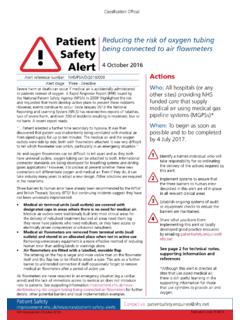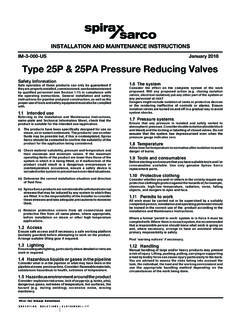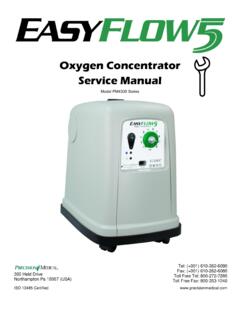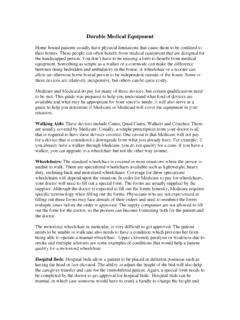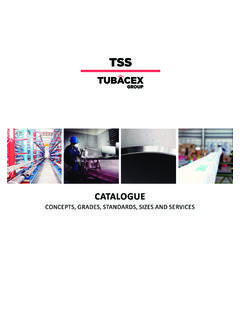Transcription of SAFETY: 8 - magnalenzindia.com
1 safety : 8 safety PRECAUTIONS The precautions. Outlined here, are well known to Melt Shop people. They are common to all metal melting operations and are not peculiar to induction melting. The following are offered as general precaution, applicable to the foundry and steel plant and cannot be constructed to cover all types of operations. We suggest that the user evaluate these precautions in light of their specific operations and expand or modify them as necessary. * Access to melting and pouring operations should be limited to authorize personnel only. * Personnel should wear safety glasses at all times and should use special light reducing glasses When viewing metal at high temperatures. * Heat and flame retardant safety clothing should be worn by personal who work at or near Furnaces.
2 * The refractory that is used to line the furnace must be suitable for the material being melted Refer to the refractory manufacture s specifications. Be sure that furnace linings have been Thoroughly dried and sintered in accordance with manufactures recommendations. * In induction melting, furnaces should be charged carefully to avoid bridging of the charge Excessive temperature in the bath below the bridge can cause rapid erosion of the furnace Lining and a dangerous run-through which could cause an explosion. To melt out a bridge After it has formed. 1st tilt the furnace to 30 to 400C and the power supply should be run at Lower power to prevent superheating. Normally about 25% above holding power is suffic- Ient to slowly melt out the bridge. Holding power is the power level required to maintain the Molten metal in a fully molten condition at constant temperature.
3 Till the molten metal come In contact with the bridge. After a hole has been melted through the bridge, return the furnace To the upright position. Then check temperature to make sure the molten metal is not super- Heated. Begin adding charge through the hole in the bridge to bring the molten metal into Contact with the bridge. Be careful not to superheat the molten metal during this procedure. If you are unable to break through the bridge. Turn the power off and contact at Magnalenz. GENERAL MELTING PRECAUTIONS: * Regularly inspect furnace lining to minimize the possibility of a dangerous run through Occurring. * The furnace lid (where one is used) should be closed before the furnace is tilted. * Charge materials must be dry and free of combustible materials and liquids.
4 If submerged Under a molten bath, can vaporize and cause a possible boil-over or explosion. * Care should be exercised when adding low melting point materials that have low vaporization Temperatures into high temperature baths. If such materials become submerged before they Melt, they can vaporize and cause a possible boil-over or explosion. * Crucibles for lift coil or push out furnaces should be used only for those metals for which they Are suitable. Generally, crucibles are not designed for the high temperatures encountered in Melting nickel, Monel, copper-nickel or ferrous materials (Refer to the crucible manufacturers Specifications regarding the materials that may be melted in crucibles). * When metal is to be transferred in a crucibles, a cradle that provides adequate bottom Support for the crucible must be used.
5 * Be knowledgeable of the chemistry of your melt. Chemical reactions such as a rapid carbon Boil can damage equipment and be dangerous. FOR Ail induction heating/melting equipment uses high-voltage power during operation. Magnalenz Built equipment is designed for safe, efficient and reliable operation with maintenance ease. If Some simple rules of operation are observed. Several safety features are built into Magnalenz equipment to provide operator protection. DO NOT OVER LOOKED THESE safety FEATURES. * Keep all cabinet doors locked and make keys available only to those who require access to the Enclosure. * Keep shields, covers and other protective devices in place at all times. An open enclosure is a Peril to personnel * Don t depend on interlock devices for protection.
6 Be sure power switches are in the Off Position before any access with the panel. * Put warning tags and padlocks on main power disconnects whenever working in cubicles, Vaults, bus trenches, or furnaces to prevent anyone from mistakenly applying power to the Equipment. * Always switch power off when lifting, pouring or transporting furnaces. WHEN CHARGING A * Use only dry charge material. * Be sure bundled or baled scrap is dry before adding to melt. * Do not allow closed or partially closed containers that may contain liquids (beverage can Sheared tubing, etc.) to be mixed with the furnace charge. Liquids or pieces of combustible material can vaporize instantly upon contacting the melt and scatter molten metal. * The above precautions are especially important with aluminum because scattered molten Particles can combine with oxygen which can result in a secondary explosion.
7 FOR MAINTENANCE * Study the Maintenance Manual. * Become familiar with the unit an its dangerous areas before attempting maintenance of any Kind. * Always use independent methods to support a tilted furnace whenever working on or near. * Never enter the high risk zone like running crucible/ ON-SOLID state generator. Always work on electrical section of furnace with main Breaker off and keep fuses With while working. MOLTEN METAL SPLASH THE MOST VISIBLE HAZARD: Wet charged materials are serious hazard in all foundries and steel plant. When molten Metal comes in contact with any water, moisture or liquid-bearing material, it instantaneously. Turns to steam, expanding to 1600 times to its original volume and producing a violent explosion.
8 This occurs without warning and throws molten metal and possibly high-temperature solids out Of the furnace and puts workers, the furnace itself and nearby plant and equipment at risk. A water/metal explosion can occur in any type of furnace. For an induction furnace, however, The after effect may be more serious and include the possibility of additional explosions caused By liquid in a ruptured cooling system coming in contact with molten metal in the bath. (See Cooling system description below.) Explosions also can occur if sealed drums or containers containing water/oil etc are charged into An empty but hot Furnace. In this case, the force of the explosion will reject the newly charged Material and quite likely damage the refractory lining as well. The violent and unpredictable nature of a water/metal explosion makes the wearing of safety Clothing by melt shop workers absolutely imperative.
9 Such clothing can prevent disfiguring and incapacitating burns as well as fatal burns. ELIMINATING WET SCRAP In foundries where most of the charge originates as scrap, wet charge materials pose the greatest Cause for concern. Some foundries reduce the possibility of water/metal explosions by storing Scrap undercover for a least one day and then carefully inspecting bales and containers for any Residual moisture. But a more reliable solution being used by an increasing number of foundries Today is to use remote charging systems with charge dryers or pre heaters. Remote charging systems permit the operators to be safely back from the furnace or behind Protective screens during charging. Dryers and pre heaters maximize the removal of water and Moisture before the scrap enters the bath.
10 SEALED CONTAINERS: An easily overlooked danger is posed by sealed containers and sections of tubing or piping that Are sheared closed in both ends. Obviously, containers holding combustible liquids or their fumes Will explode lone before the scrap itself melts. Pre heating sealed materials will not prevent this Hazard. In fact, there is a risk that a sealed container will explode inside the pre heating systems. Operator vigilance is the only preventive measure. Sealed material must never be permitted into The furnace or preheated. Sheared sections of scrap tube and pipe and apparently empty sealed Containers may seem less dangerous, but can be equally hazardous. Even though they do not Contain combustible liquids; the air inside them can rapidly expand in the heat. In extreme cases The pressure buildup will up be sufficient to breach the container wall or escape through a sheared Closed end.
